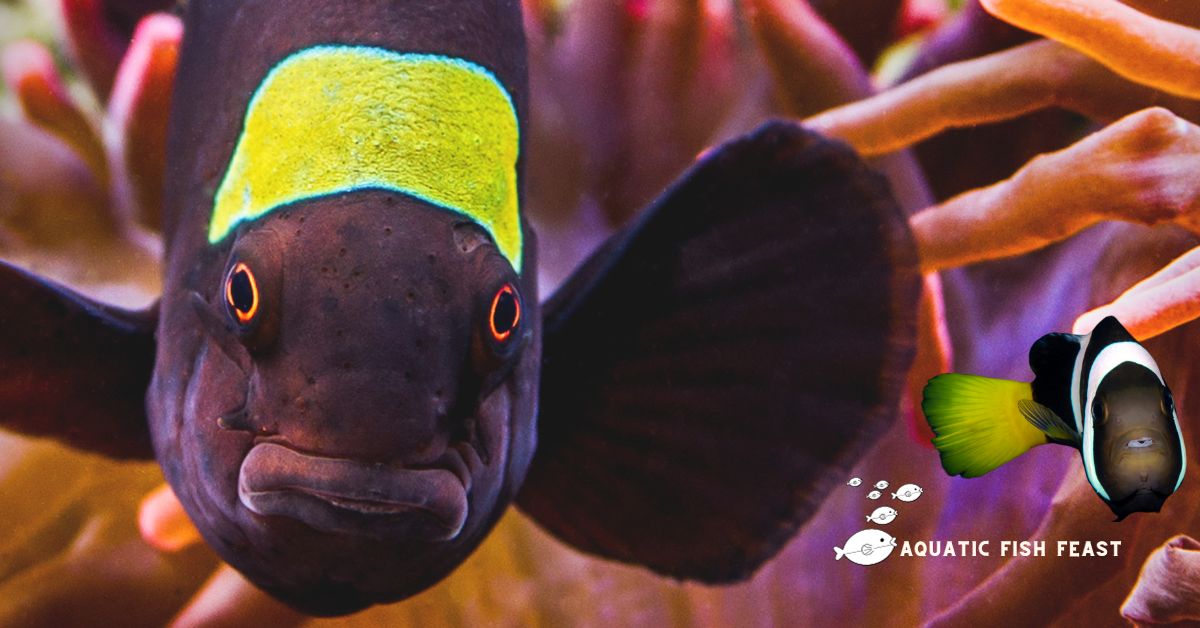Do you want to know why do clownfish turn black? Does the color of your clownfish get darker? What makes clownfish black?
Is this something normal or not normal? There’s a chance the answer is easy, but we should check again.
Well, based on what I’ve seen and heard, as you read this piece, I will teach you about clownfish changing color and a lot more.
Now, let’s get started.
Table of Contents
Can Clownfish Turn Black
Yes. Alterations in nutrition or the surrounding environment might cause clownfish to develop a black coloration.
The fact that some clownfish in the wild are born black is one of the reasons why these color differences are perfectly acceptable.
You should only be concerned if you observe a change in the clownfish’s behavior.
A clownfish that is sluggish may begin to move more slowly, whereas a clownfish that is frenzied may begin to dart about the tank more quickly.
A straightforward shift in coloration can reveal how much time has passed since they were born.
There is also the possibility that they are demonstrating one of their physical characteristics to us.
Are Black Clownfish Natural
Clownfish that are naturally black can be found in the wild. The most prevalent kind is the Black Ocellaris, which is entirely black with just white bands, as the name suggests.
This fish belongs to the Amphiprion ocellaris species, commonly called the Common Clownfish, and is not a member of any other species.
The fascinating thing about these black variations of this species is that their natural color depends on where they live.
Though associations with the host anemone have also been observed, this suggests that there may be a sizeable genetic variance between them and their fellow clownfish of the same species who have the more conventional colors that we are so accustomed to.
There are more species than Amphiprion ocellaris that have these virtually entirely black fish in the wild.
Although the Black Clownfish appears to be the only species that may have precisely zero non-neutral colors, several other clownfish species have individuals that are at least overwhelmingly black and have very few colors that are not neutral.
The Amphiprion genus includes the Sebae Clownfish, Saddleback Clownfish, and Wide-Band Anemonefish as additional species of clownfish that can naturally be primarily black.
Nevertheless, this is not an isolated instance; this color expression is somewhat common in this species.
Are Clownfish Black
Clownfish that eventually become black have an orange hue while young but become black as they age.
The ones that we sell are almost often all black; however, they occasionally contain orange highlights on the face.
As they become older, all of the orange color fades, leaving behind the only solid black and white clownfish that can be found in nature.
Researchers have debated whether or not the Black clownfish should be classified as a distinct species, but for the time being, they are still categorized as a subspecies of the A. clownfish species.
What Are The Reasons Why Clownfish Turn Black
Here are the Principal Causes of Clownfish Turning Black: Clownfish are fish kept in reef tanks or community aquariums of choice by aquarists.
Even with the most significant living conditions, these vividly colored fish might eventually turn black.
The following factors are primarily responsible for the color shift in clownfish.
1. Growing Older:
One of the leading causes of clownfish becoming black is aging.
It’s well known that several species of clownfish darken with age.
Among the many species that turn black with age are Maine Mocha clownfish, Onyx, and Black Ocellaris.
Some species of clownfish do not entirely become black. As they age, their color gradually darkens and becomes more noticeable.
2. Gender Shift:
Gender change is another factor contributing to the blackening of clownfish. Protandrous hermaphrodites are clownfish.
Clownfish are all male at birth.
When the group’s female member dies, the dominant male changes gender to become a female to procreate.
Clownfish may transform into females when necessary, thanks to their male and female reproductive systems.
When a clownfish species switches genders and uses its female reproductive organs, it often gets darker.
They seem black as they become a deeper tint than usual.
Do All Clownfish Become Dark As They Age
Not every species of clownfish gets darker with age. Clownfish are of more than 30 species, and they all look distinctive.
- Some of them never even become black.
- Clownfish species influence whether or not they will become black with age.
- For instance, as they age, Black Ocellaris clownfish get dark.
When these clownfish are young, they are orange; as they age, they turn black.
Another well-known species for gradually becoming darker is the Onyx clownfish, sometimes called the Percula clownfish.
- The black color of onyx clownfish progressively shows up as the fish ages.
- This may not be apparent until the fish reaches adulthood.
- This is a result of the pigment’s protracted development.
The orange color of the onyx clown fish’s head and tail persists, but the center of their body turns black.
Maine Mocha clownfish is another illustration. Because of its diverse patterns and colors, this fish is unlike any other.
As they become older, these fish also become darker. Some of them wholly become black, but the nose stays orange-brown.
Another well-known species for gradually becoming darker is the Onyx clownfish, sometimes called the Percula clownfish.
- The black color of the onyx clownfish progressively shows up as the fish ages.
- This may not be apparent until the fish reaches adulthood.
- This is a result of the pigment’s protracted development.
The orange color of the onyx clownfish’s head and tail persists, but the center of its body turns black.
Maine Mocha clownfish is another illustration. Because of its diverse patterns and colors, this fish is unlike any other.
As they become older, these fish also become darker. Some of them wholly become black, but the nose stays orange-brown.
How To Prevent Clownfish From Losing Their Color
Protect the water around clownfish as clean as possible to protect them from becoming lifeless.
Check the temperature, pH, specific gravity, and filter regularly since these factors are critical to the health of fish.
In addition, do partial water changes every two weeks, taking out as much as 15% of the existing liquid and adding fresh, treated water in its place (depending on how well-populated the aquarium is).
As artificial lighting in aquariums may also impact the coloring of clownfish, attempt to minimize the time the lights are on throughout the day and provide fish somewhere to hide.
Fish should only be exposed to too-bright rays for eight hours a day to avoid stressing them out. It is advised to use a multi-spectrum LED aquarium light with a moonlight or ambient function.
The lack of oxygen in the tank is yet another potential reason why the color of the clownfish is fading. Clownfish may experience stress and lose their vibrancy if there is insufficient oxygen circulation in the water.
To prevent this, consider adding another filter, installing an air pump, connecting a spray bar to the filter’s output, or utilizing air stones in the aquarium to increase surface agitation or water movement.
Final Thought
Now that we have established Why clownfish turn black, Clownfish are not made equally. Observing the diversity and distinctive characteristics of several clownfish is entertaining.
You shouldn’t be concerned if they change color unless their behavior changes.
It is more worrying when a clownfish becomes lighter than when it becomes darker. Clownfish’s vivid colors may be preserved mainly by keeping a healthy environment and feeding them nutrients.
With our clownfish, let’s play about and appreciate their diverse forms, tones, and dimensions.




